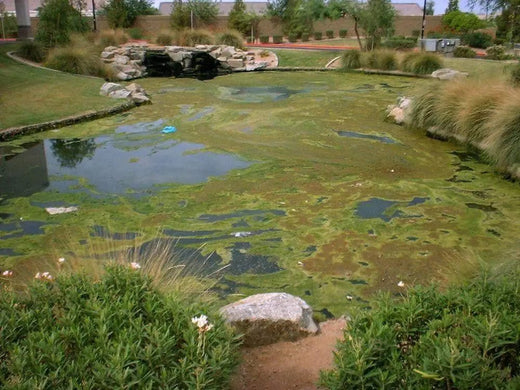Introduction
Pond algae can be a nuisance for pond owners, affecting water quality and the ecosystem's overall health. Fortunately, pond aeration offers a practical solution to effectively control and reduce algae growth. Aeration systems can help maintain a balanced pond environment by increasing oxygen levels and promoting water circulation. In this article, we will explore what pond algae is, why it grows, the importance of controlling it, and answer, "Does pond aeration reduce algae." We'll delve into the significant role that pond aeration plays in improving algae control and enhancing your pond's health and beauty.
What is Pond Algae?
Pond algae are simple, photosynthetic organisms that thrive in aquatic environments. These organisms can range from microscopic phytoplankton to large, stringy mats of filamentous algae. While some algae are beneficial and essential for the pond ecosystem, providing oxygen and serving as a food source for aquatic life, excessive algae growth can lead to several problems. Algae blooms can deplete dissolved oxygen levels, killing fish and creating unpleasant odors. They can also block sunlight from reaching submerged plants, disrupting the pond's natural balance. Understanding the nature of pond algae is the first step in managing and controlling its growth.
Why Does Pond Algae Grow?

Pond algae grow primarily due to the availability of sunlight, nutrients, and stagnant water conditions. Nutrients such as nitrogen and phosphorus, often from runoff containing fertilizers, animal waste, or decaying organic matter, fuel algae growth. Stagnant water creates an ideal environment for algae to thrive, as it limits water movement and oxygen exchange. Additionally, warm temperatures can accelerate algae reproduction, leading to rapid blooms. Understanding these growth factors is crucial for effective algae control. By addressing the root causes, such as reducing nutrient inputs and improving water circulation, pond owners can manage algae growth more effectively and maintain a healthier pond ecosystem.
Importance of Pond Algae Control
Water Quality
Pond algae control is essential for maintaining good water quality. Excessive algae can deplete oxygen levels in the water, leading to hypoxia or anoxic conditions that harm fish and other aquatic organisms. It can also produce toxins that pose health risks to wildlife and humans. Implementing pond aerators can enhance water quality by increasing oxygen levels and promoting the breakdown of organic matter, thereby reducing the nutrients available for algae growth.
Aesthetic Appeal
Algae blooms can significantly detract from a pond's aesthetic appeal. Thick algae mats floating on the surface can make the water look murky and uninviting. Maintaining clear water through effective algae control methods, such as pond aeration, can enhance the visual appeal of your healthy pond, making it a more enjoyable and attractive feature in your landscape.
Biodiversity
A balanced pond ecosystem supports diverse aquatic life. Excessive algae growth can disrupt this balance by outcompeting other plants for nutrients and light, decreasing biodiversity and affecting the entire ecosystem's health. Pond aeration helps maintain the balance by promoting the growth of beneficial bacteria, which compete with algae for nutrients and help keep blue-green algae populations in check.
Recreational Use
Many often use ponds for recreational fishing, swimming, and boating. Excessive algae can make these activities less enjoyable or even hazardous. Algae blooms can produce slippery surfaces and foul odors, reducing the pond's usability. Like lake weed control, controlling algae through pond aeration can ensure that your pond remains a safe and pleasant environment for recreational activities.
Wildlife Health
Algae control is crucial for the health of wildlife that relies on the pond ecosystem. Excessive algae can create toxic conditions and deplete oxygen levels, threatening fish, amphibians, and other wildlife. Aeration helps maintain a healthy habitat for these creatures.
Water Resources
Effective algae control helps preserve water resources. Algae blooms can lead to water quality issues that necessitate costly treatments and interventions. By maintaining a balanced pond environment through aeration, you can minimize these risks and ensure the longevity and sustainability of your water resources.
How Can You Control Pond Algae?
Controlling pond algae involves a combination of preventive and active management strategies. Implementing a pond aeration system is one of the most effective methods for reducing algae growth. Aeration increases oxygen levels and promotes water circulation, which helps prevent the stagnant conditions that favor algae blooms. Additionally, pond algaecide can provide immediate relief from a severe algae problem, though you should use it judiciously to avoid harming beneficial aquatic life.
Regularly removing debris and organic matter from the pond can reduce nutrient loads that contribute to algae growth. Installing pond filters and using a muck reducer can enhance water quality by removing excess nutrients and organic material. Introducing beneficial aquatic plants for larger ponds can help compete with algae for nutrients and light, creating a more balanced ecosystem.
Lastly, monitoring and managing nutrient inputs from external sources, such as runoff from fertilized lawns or agricultural fields, is essential for long-term algae bloom control. By addressing the underlying causes and combining these strategies, pond owners can effectively manage algae growth and maintain a healthy, beautiful pond environment.
Conclusion

Pond aeration is a powerful tool in the fight against algae, offering numerous benefits for water quality, aesthetics, and ecosystem health. By understanding the factors contributing to algae growth and implementing effective control measures, including aeration, pond owners can enjoy a clear, vibrant pond year-round. For expert advice and high-quality pond aeration systems, visit Smith Creek Fish Farm and explore their wide range of pond accessories and solutions.

